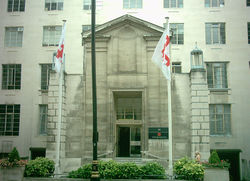English Heritage
 |
|
| Status | Non-departmental public body |
|---|---|
| Territory | England |
| Leadership | Simon Thurley |
| Founded | 1983 |
| Website | english-heritage.org.uk |

English Heritage (formally the Historic Building and Monuments Commission for England).[1] is a non-departmental public body of the United Kingdom government with a broad remit of managing the historic built environment of England. It is currently sponsored by the Department for Culture, Media and Sport. Simon Thurley has been chief executive since 2002.
It was set up under the terms of the National Heritage Act 1983. Its functions for maintaining ancient monuments had previously been undertaken by part of the Department of the Environment which was the successor to the Ministry of Works. The 1983 Act also dissolved the bodies that had hitherto provided independent advice — the Ancient Monuments Board for England and the Historic Buildings Council for England and incorporated these functions in the new body. Another advisory body, the Royal Commission on the Historical Monuments of England (RCHME) was not merged with English Heritage until 1 April 1999.[2]
English Heritage's best known role is as the steward of over 400 significant historical and archaeological sites, from Stonehenge to the world's earliest iron bridge. In 2007/08 5.3 million visits were paid to staffed English Heritage properties.[3] It also has major responsibilities in conservation, giving advice, registering and protecting the historic environment. It also maintains a public archive, the National Monuments Record (NMR).
Contents |
Domain
By caring for the built environment, English Heritage complements the work of Natural England which aims to protect the natural environment. Both advise the relevant Secretary of State on policy and in individual cases such as registering Listed buildings and Scheduled Ancient Monuments in EH's case. English Heritage has direct ownership over some historic sites and also liaises with private owners of sites that are managed under guardianship arrangements.
English Heritage describes itself in these terms:
- "English Heritage is the Government's statutory adviser on the historic environment. Officially known as the Historic Buildings and Monuments Commission for England, English Heritage is an Executive Non-departmental Public Body sponsored by the Department for Culture, Media and Sport (DCMS). Our powers and responsibilities are set out in the National Heritage Act (1983) and today we report to Parliament through the Secretary of State for Culture, Media and Sport."
English Heritage is thus an unelected quango with a considerable degree of power and access to public money derived from taxation. At some of its properties it charges admission fees to supplement its government funding. In 2007/08 it generated income of £49 million, received government grants of £137 million and spent £172 million.[4]
It may be contrasted with the National Trust which is an independent registered charity operating in the same sector.
Membership
Members of the public are able, and encouraged, to join English Heritage. Membership confers benefits such as free admission to its properties. In 2007/08 membership was 665,000.[5] However, it does not give the member a say in the running of the organisation. In contrast, such policy is common for similar organisations, such as the National Trust.
Images of England
Images of England is an English Heritage project intended to create a freely accessible online database of the 370,000 listed properties in England. Each database entry includes a representative photograph and a description of the building written by an expert architectural historian.
Controversies
English Heritage sites in Cornwall
In 1999 there was some controversy regarding sites in Cornwall under the care of English Heritage. The pressure group, the Revived Cornish Stannary Parliament wrote to English Heritage asking them to remove all signs bearing their name from Cornish sites by July 1999 as they regard the ancient sites as Cornish heritage, not English. Over eleven months members of the Cornish Stannary removed 18 signs and a letter was sent to English Heritage saying "The signs have been confiscated and held as evidence of English cultural aggression in Cornwall. Such racially motivated signs are deeply offensive and cause distress to many Cornish people". On January 18, 2002, at Truro Crown Court, three members of the group agreed to return the signs and pay £4,500 in compensation to English Heritage and to be bound over to keep the peace. In return, the prosecution dropped charges of conspiracy to cause criminal damage.[6]
Many English Heritage signs in Cornwall have been defaced or removed entirely.
Fortress House

In 2006, The Secretary of State at the DCMS issued a certificate of exemption from listing for Fortress House, the then English Heritage headquarters.[7] In 2009, it was demolished and the site redeveloped for a commercial office building.[8]
Equivalent organisations
- Wales — Cadw
- Scotland — Historic Scotland
- Northern Ireland — Northern Ireland Environment Agency (formerly the Environment and Heritage Service)
- Isle of Man — Manx National Heritage
See also

- Conservation in the United Kingdom
- Blue plaque
- Buildings at Risk Register
- Department for Culture, Media and Sport
- Historic houses in England
- List of English Heritage properties
- National Register of Historic Parks and Gardens
- National Trust Properties in England
- Abbeys and priories in England
- Castles in the United Kingdom
- Heritage film
- Heritage Open Days
- List of Conservation topics
- List of heritage registers
- Museums in England
- Battle of the Beanfield
- Jennifer Page former Chief Executive 1989-95 and Chief Executive of the London Millennium Dome project from 1995-2000.
References
- ↑ Who We Are About Us English Heritage
- ↑ Conservation Bulletin, Issue 35, April 1999
- ↑ English Heritage annual report 2007/08, page 14.
- ↑ English Heritage annual report 2007/08, page 42-45.
- ↑ English Heritage annual report 2007/08, page 14.
- ↑ BBC news January 2002 — Historic signs case trio bound over
- ↑ http://www.c20society.org.uk/casework/reports/2006/fortress-house-threatened.html
- ↑ http://www.macegroup.com/projects/project-library/23-savile-row
External links
- English Heritage website
- Images of England website
- The English Heritage Photo Archive
- Chief Executive website
- Director of Property Presentation - Dr Anna Keay
|
|||||||||||||||||||||||||||||||